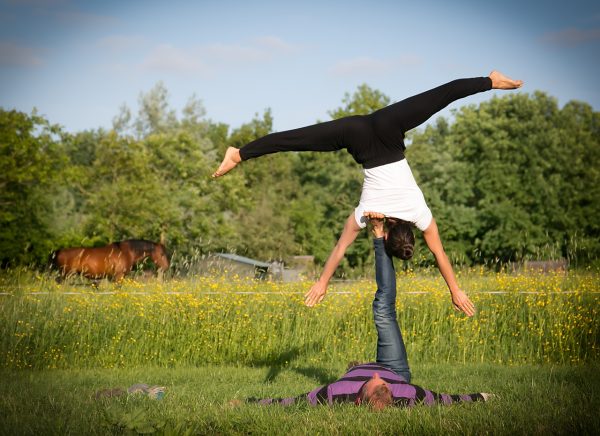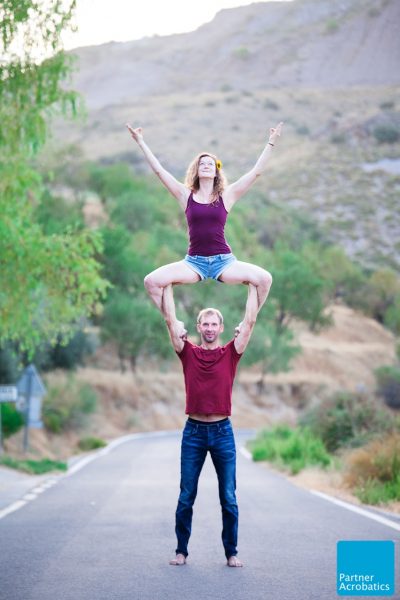See also my blog entry on akro.dk: Should I start with acroyoga?
I first encountered acroyoga at Move Copenhagen 20131 (first year it existed) and it has since then taken over my life! I was a devote rock climber, spending lots of my time in the training gym and my all of my vacation on climbing trips. Rock climbing was the perfect sport for me because it included physical strength, mental focus, balance and flexibility, and outdoor camping. What else could you ask for? Turns out, the answer was Acroyoga.
I still love (the idea of) rock climbing, but I rarely get to practice it anymore. My time simply got taken over by acroyoga. In addition to all the things rock climbing gives me2 there is the challenge and joy of working together with a partner (or more partners). Encountering acroyoga opened up a whole new world for me of being together with people, sharing the present moment with touch, laughs, creativity and personal development – both physically and mentally.
In the later years my focus has moved more to the standing acrobatics part. I find that the need for connection with my partner is even-more important (i.e. we need to be fully connected in our tempo to make our tricks a reality) and somehow I find that challenge motivating 🙂
Teaching acro
Throughout my years I have been teaching what I have been doing. In my late teens I was teaching badminton, at uni I was a teaching assistant, and I have also taught rock climbing (before I got sucked into acro). I love teaching and especially acroyoga has been amazing to teach. Seeing people giving and receiving trust, and to step past what they thought they could not do – and the joy that that facilitates – is always fun to be a part of.
The famous Richard Feynman (theoretical physicist and story teller) had a quote on his blackboard:
What I cannot create, I do not understand.
I would like to paraphrase that…
What I cannot teach, I do not understand.
I think this is an important point. I love geeking out about technique and finding out what works and what doesn’t – and also how to teach it. But both teaching and practicing acroyoga is much more than that; here are a few words that I like to have focus on in my practice, and that I hope also comes out in my teaching:
Technique
What is technique? I think there could be many definitions, but a part of it could be “to learn to use your body in a way that makes it easy for you and your partner.” This ranges from explicit knowledge of hand or feet position, to (perhaps implicit) activation (and training) of the minor stabilizing muscles to become more stable in the pose. As a teacher, I feel it is important for me to reflect on this in order to be able to better help students with their challenges.
Exploration
To stop up, look around, and take a path you have not taken before. I think this is an important aspect of acroyoga; an important contributor to the play. To break out of the known washing machines3 and routines you have made, to challenge yourself and your partner to be creative.
Also, talking about technique, I like to give space to my students to explore technique for themselves. Having lots of detailed tips often makes you fall into the pitfall of talking too much. I find it much better to let people go out quickly and learn for themselves. Discovering for yourself what works and what does not is a much better teacher than me telling you everything 🙂
Communication
… is an important part in acro as in the rest of your life. Because we are so dependent on each-other in acro, this is a really good place to learn this soft skill. One thing I often return to is the question “What can I do to help you?” – in one form or another. Even if I have a pre-formed assumption of what is wrong (and it is my partner’s fault :-p ) I still ask this question. Often it comes back to me; that it starts with me and I can make a small change to help my partner to success. This (and more) I like to encourage my students to practice as well.
Trust, calmness and spotting
Here, climbing and acroyoga really share something in common. If I don’t trust my belay partner when climbing, I do not perform very good. If I don’t trust my base when flying, then the same. I have been told that I bring a lot of calmness and trust into both my practice and to my teaching, and with that, a feeling of safety. I like that; I find that, like climbing, the feeling of trust and safety immensely improves performance and the joy of working together. But it must not be a feeling only, and therefore spotting is important. Both in self assessment and choosing to work with a spotter, but also to teach and practice good spotting technique.
Most of all, I really just hope to be a facilitator or a coach for you to (through acro or other activities) discover yourself and where you can go.

Teacher certifications
Acroyoga and acrobatics teacher certifications:
- Partner Acrobatics teacher training, August 2017.
- Acroyoga Montreal teacher training, April 2018.
Bio to use in PR contexts
Jørn was introduced to acroyoga in 2013 and it has since then taken over his life. Coming from a climbing background, he had a lot of experience with geeking out on technique, trust, and physical training, but acroyoga added the dimensions of softness, communication, creativity, and teamwork.
Jørn’s interests are currently focused on Icarians and standing acrobatics. The requirements towards the tempo connection between the partners in dynamic tricks are just that more challenging – but when it succeeds, it really makes the flyer fly!
Being a professional geek (engineer by trade), he still loves to dive deep into aspects of technique, skills and breaking things down. Acroyoga and acrobatics is both hard work and the ease of play, but when hard work takes over the ease of play, then something is wrong. How do we break things down? And what small things can we change such that the ease of play comes back? This is what Jørn uses his sparetime on finding out.
Come play with him. What will you find out?
Jørn is a certified Partner Acrobatics (2017) and Acroyoga Montreal (2018) teacher.

- Now, unfortunately, only existing in the web archive. ↩︎
- Ok, so the physical strength is a bit different placed on your body, and there is (usually) not so much camp life involved. ↩︎
- For the uninitiated; a Washing Machine is a sequence of poses and transitions that comes back to the starting position, so that you can perform it over and over in a flow. ↩︎